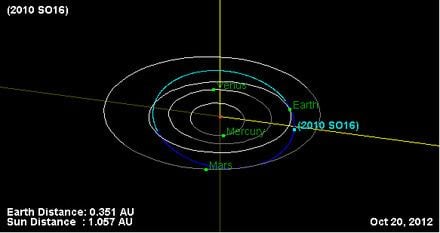Discovery date 17 September 2010 Eccentricity 0.075351 Discovered 17 September 2010 Argument of perihelion 108.804° | Observation arc 1928 days (5.28 yr) Orbital period 366 days Inclination 14.522° | |
 | ||
Aphelion 1.07791 AU (161.253 Gm) Semi-major axis 1.00237 AU (149.952 Gm) Similar | ||
(419624) 2010 SO16 is a near-Earth asteroid discovered by the Wide-field Infrared Survey Explorer space telescope. The orbit was described by Christou Apostolos and David Asher at the Armagh Observatory in Northern Ireland. The object has a magnitude of 20.7 and is several hundred meters in diameter.
2010 SO16 has a horseshoe orbit that allows it to stably share Earth's orbital neighborhood without colliding with it. It is one of a handful of known asteroids with an Earth-following orbit, a group that includes 3753 Cruithne, and the only known asteroid in an horseshoe orbit with Earth. It is, however, neither an Aten asteroid nor an Apollo asteroid because the semi-major axis of its orbit is neither less than nor greater than 1 AU, but oscillates between approximately 0.996 and 1.004 AU, with a period of about 350 yr. In its ~350 yr horseshoe cycle, it never approaches Earth more closely than about 0.15 AU, alternately trailing and leading.
According to various simulations 2010 SO16 will remain in this orbit for at least 120,000 years and possibly for more than a million years, which is unusually stable compared to other similar objects. One reason for this stability is its low orbital eccentricity,
A precovery of 2010 SO16 may have been located in a 2005 Spitzer Space Telescope image.
